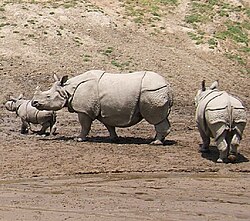Top Qs
Timeline
Chat
Perspective
Rhinoceros (genus)
Genus of mammals From Wikipedia, the free encyclopedia
Remove ads
Rhinoceros is a genus comprising one-horned rhinoceroses. This scientific name was proposed by Swedish taxonomist Carl Linnaeus in 1758.[1] The genus contains two species, the Indian rhinoceros (Rhinoceros unicornis) and the Javan rhinoceros (Rhinoceros sondaicus). Although both members are threatened, the Javan rhinoceros is one of the most endangered large mammals in the world with only 60 individuals surviving in Java (Indonesia). The word 'rhinoceros' means "nose-horn" in Ancient Greek.[clarification needed]
This article needs additional citations for verification. (April 2016) |
Remove ads
Etymology
The genus name Rhinoceros comes from the Ancient Greek words ῥινο- (rhino-), meaning "of the nose" and κέρας (kerás), meaning "horn".[2][3]
Classification
Summarize
Perspective
The genus Rhinoceros comprises:
- Indian rhinoceros (R. unicornis) Linnaeus, 1758[1] Indian subcontinent
- Javan rhinoceros (R. sondaicus) Desmarest, 1822[4] Southeast Asia
- †R. sivalensis Falconer and Cautley, 1846 northern Indian subcontinent (Siwalik Hills) Pliocene-Early Pleistocene
- †R. platyrhinus Falconer and Cautley 1847 syn Punjabitherium Khan (1971) Upper Siwaliks, Indian subcontinent, Early Pleistocene to early Middle Pleistocene, India. Largest species in the genus.[5]
- †R. sinensis Owen, 1870[6] Has been used as a wastebasket taxon[7] used to refer to rhinoceros material from the Pleistocene of China, with various specimens belong to other Rhinoceros species, Dicerorhinus and Stephanorhinus,[8] though it is possible that some remains attributed to Rhinoceros sinensis represents a valid and distinct species of Rhinoceros.[5]
The earliest remains of the genus are known from the Late Miocene, represented by remains such as an indeterminate species found in deposits in Myanmar dating to around 8-9 million years ago.[9]
The species "Rhinoceros" philippinensis from the early Middle Pleistocene of the Philippines and "Rhinoceros" sinensis hayasakai from the Early-Middle Pleistocene of Taiwan have been transferred to Nesorhinus, which appears to be closely related to Rhinoceros.[10] While Rhinoceros fusuiensis Yan et al. 2014[11] from the Early Pleistocene of South China has been transferred to Dicerorhinus.[10][12]
Relationships among Late Pleistocene and modern rhinoceros genera, based on nuclear DNA, after Liu et al, 2021:[13]
| |||||||||||||||||||||||||||||||||||||||||||
Bayesian morphological phylogeny after Pandolfi, 2023 Note: This excludes living African rhinoceros species.[14]
| ||||||||||||||||||||||||||||||||||||||||||||||||||||||||||||||||||||||||||||||||||||||||||||||||||||||||||||||||
Remove ads
References
External links
Wikiwand - on
Seamless Wikipedia browsing. On steroids.
Remove ads

